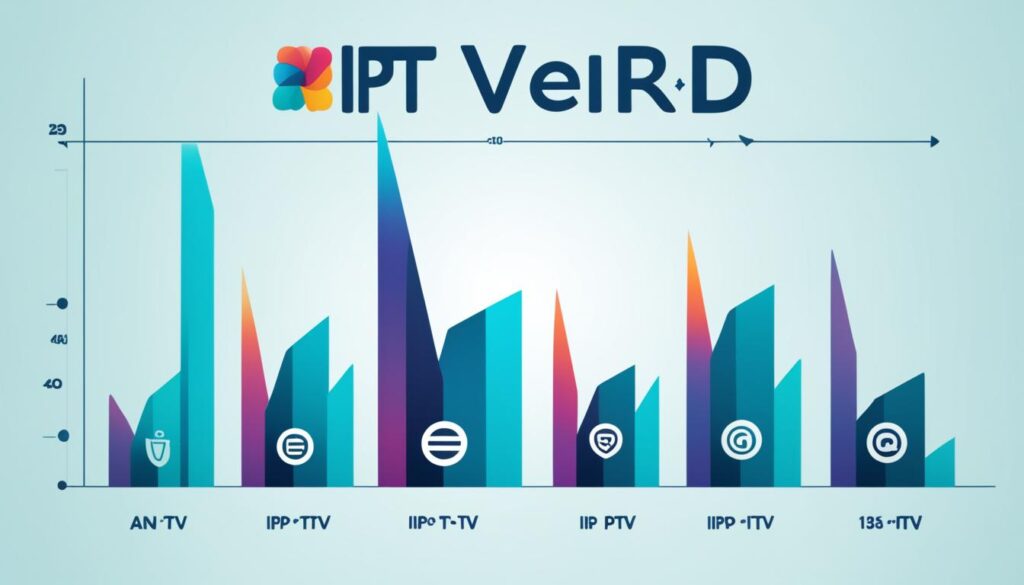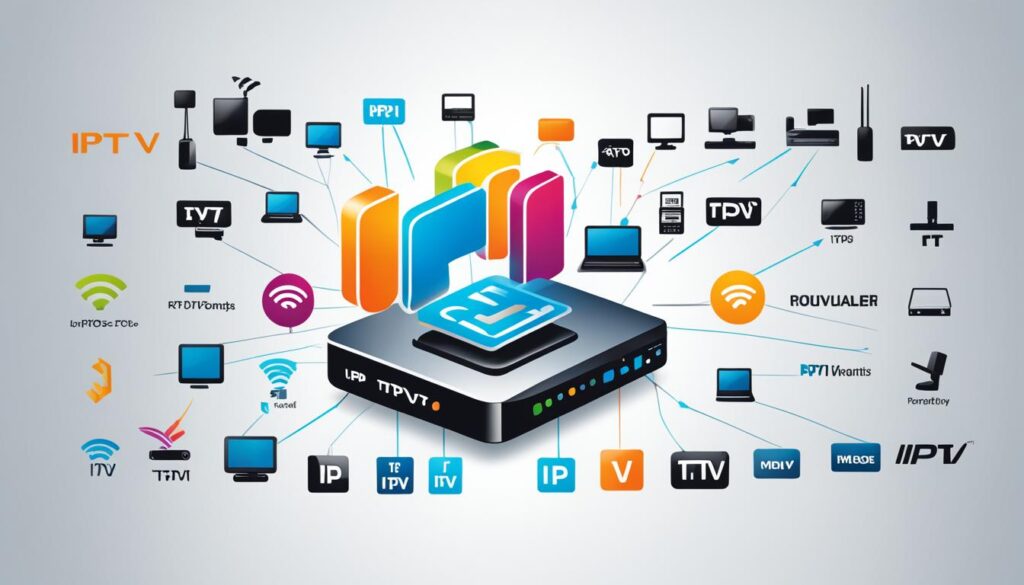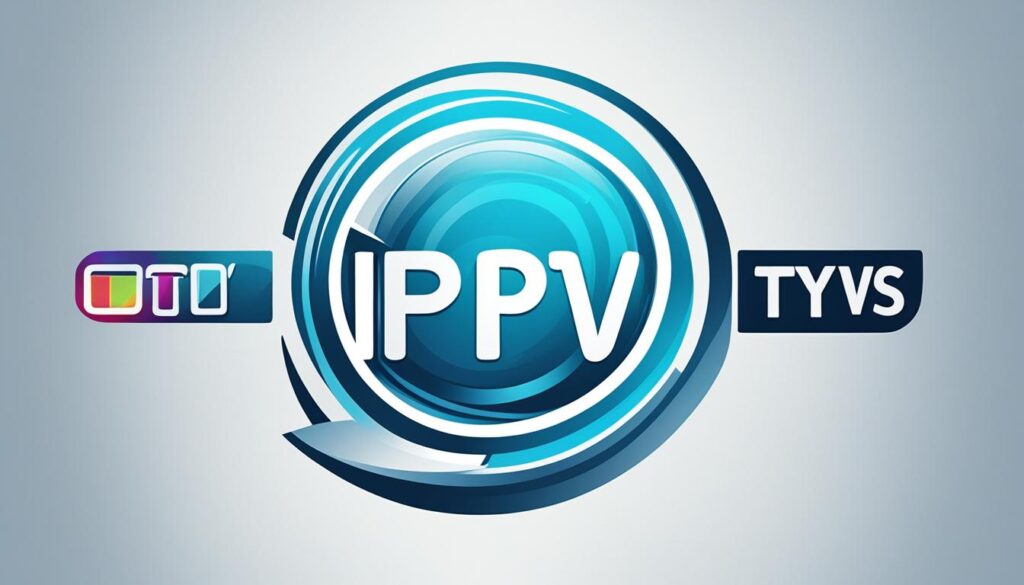Did you know that the global IPTV market is projected to reach a staggering USD 211.32 billion by 2030? This exponential growth, with a CAGR of 17.4% over the forecast period, is a testament to the rapid advancements and innovations in the world of digital streaming.
As more and more consumers embrace the convenience and flexibility of IPTV services, the industry is witnessing a transformative shift in how we consume digital content. From personalized viewing experiences to integrated smart home systems, the future of IPTV is filled with exciting possibilities.
Key Takeaways:
- IPTV market is projected to reach USD 211.32 billion by 2030.
- Advancements and innovations in digital streaming are driving the growth of IPTV.
- Consumers are embracing IPTV services for their convenience and flexibility.
- The future of IPTV includes personalized viewing experiences and integrated smart home systems.
- The industry is witnessing a transformative shift in how we consume digital content.
IPTV Market Size and Growth
The global IPTV market is experiencing significant growth, driven by the increasing demand for IPTV services and the expanding market share of service providers. In 2022, the market size was estimated to be USD 59.68 billion, and it is projected to reach USD 211.32 billion by 2030. This represents a remarkable growth rate and showcases the immense potential of the Internet Protocol Television market.
Factors Driving Market Growth
- Rising demand for IPTV services: Consumers are increasingly shifting towards IPTV services due to their convenience, cost-effectiveness, and the ability to access a wide range of content.
- Expanding market share of service providers: Service providers are actively expanding their offerings and enhancing their platforms to cater to the growing demand, resulting in increased market penetration.
Market Size Comparison
To better understand the growth of the IPTV market, let’s compare its size with other segments of the digital entertainment industry.
| Segment | Market Size (2022) | Market Size (2030) | Growth Rate |
|---|---|---|---|
| IPTV | USD 59.68 billion | USD 211.32 billion | 255.5% |
| Video Streaming | USD 50.12 billion | USD 187.99 billion | 275.0% |
| Cable & Satellite TV | USD 217.48 billion | USD 190.32 billion | -12.5% |

This table demonstrates the rapid growth of the IPTV market, outpacing other segments such as video streaming and traditional cable & satellite TV. The IPTV market is set to flourish in the coming years, providing immense opportunities for businesses operating in this space.
Key Players in the IPTV Market
In the highly competitive IPTV market, several key players have emerged as industry leaders. These companies are driving innovation, expanding their market reach, and shaping the future of digital streaming. Let’s take a closer look at some of the prominent IPTV providers:
Telekom Deutschland GmbH
As one of the largest telecommunications providers in Germany, Telekom Deutschland GmbH offers IPTV services that deliver a wide range of content to customers. The company focuses on delivering high-quality streaming experiences and has made significant investments in advanced technologies to enhance their platform functionality.
Tripleplay Services Ltd.
Tripleplay Services Ltd. is a leading global IPTV and digital signage solution provider. They specialize in delivering content across a wide range of devices, including smart TVs, mobile devices, and digital signage displays. With their comprehensive suite of solutions, Tripleplay Services Ltd. caters to various industries, including corporate, hospitality, and sports arenas.
TelergyHD
TelergyHD is known for its cutting-edge IPTV solutions that enable seamless multimedia experiences. The company offers a robust platform with features such as video on demand, live streaming, and interactive TV. By leveraging advanced technologies like AI and machine learning, TelergyHD continues to push the boundaries of what IPTV can offer.
MatrixStream Technologies, Inc.
MatrixStream Technologies, Inc. is a pioneer in IPTV solutions, providing end-to-end streaming platforms to service providers. Their comprehensive offerings include hardware and software solutions that deliver high-quality video content across various devices. By focusing on scalability and reliability, MatrixStream Technologies, Inc. has established itself as a trusted player in the IPTV market.
Muvi
Muvi is a leading IPTV platform provider that empowers content owners to launch their own streaming services. With Muvi’s comprehensive suite of tools and features, businesses can easily monetize their content and deliver personalized viewing experiences to their audience. Muvi’s user-friendly interface and robust backend infrastructure make it a preferred choice among content creators.
MwareTV
MwareTV offers an end-to-end IPTV platform that enables seamless content delivery and enhanced viewer engagement. The company focuses on providing a white-label solution that allows service providers to customize and brand their IPTV offerings. MwareTV’s platform is built on cloud solutions, ensuring scalability and flexibility for operators.

These key industry players are at the forefront of driving innovation and delivering exceptional IPTV experiences to users worldwide. Through their investments in advanced technologies and commitment to enhancing platform functionality, they continue to shape the future of the IPTV market.
Key Players in the IPTV Market
| Company | Key Features |
|---|---|
| Telekom Deutschland GmbH | High-quality streaming experiences, advanced technologies |
| Tripleplay Services Ltd. | Comprehensive IPTV and digital signage solutions |
| TelergyHD | Innovative IPTV solutions leveraging AI and machine learning |
| MatrixStream Technologies, Inc. | End-to-end streaming platforms with reliable video content delivery |
| Muvi | White-label IPTV platform for content owners |
| MwareTV | Customizable IPTV platform built on cloud solutions |
IPTV Market Segmentation
The IPTV market is segmented based on various factors including deployment type, application, enterprise type, sector, and geographic region. This segmentation allows for a more targeted approach in understanding market trends and catering to specific customer segments.
Deployment Type
There are two main types of deployment in the IPTV market: hardware and software. Hardware deployment involves the use of physical devices such as set-top boxes, routers, and receivers to enable IPTV services. Software deployment, on the other hand, utilizes applications and software solutions to deliver IPTV content.
Application
The application segment of the IPTV market encompasses different devices through which IPTV services can be accessed. This includes desktops and laptops, smart TVs, smartphones, and tablets. With the increasing popularity of streaming on multiple devices, IPTV providers are developing applications to cater to diverse user preferences.
Enterprise Type
IPTV services are utilized by various types of enterprises across different sectors. These include retail, corporate and enterprise, media and entertainment, healthcare, hospitality, and others. Industries such as media and entertainment and hospitality heavily rely on IPTV for content delivery and customer engagement.
Sector
The IPTV market is further segmented based on specific sectors such as retail, corporate and enterprise, media and entertainment, healthcare, hospitality, and others. Each sector has unique requirements and preferences when it comes to IPTV services, leading to customized solutions that cater to their specific needs.
Geographic Region
IPTV market segmentation also takes into account the geographic regions in which the services are provided. Key regions analyzed include North America, South America, Europe, Middle East and Africa, and Asia Pacific. The growth and adoption of IPTV services may vary across regions due to factors such as internet infrastructure and consumer preferences.
The IPTV market segmentation provides valuable insights for industry players to devise effective strategies and target the right customer segments. By understanding the different deployment types, applications, enterprise types, sectors, and geographic regions, companies can better position themselves to meet the diverse needs of the IPTV market.
IPTV Market Analysis by Component
When analyzing the IPTV market, it is essential to consider the different components that make up this thriving industry. The market can be divided into two key segments: hardware and software. Let’s take a closer look at each of these components and their significance in the IPTV ecosystem.
Hardware
Hardware components play a crucial role in setting up and accessing an IPTV system. These components include:
- Set-top boxes
- Routers
- Gaming consoles
- Receivers
In 2022, hardware components accounted for the largest market share in the IPTV industry. Set-top boxes, which connect the IPTV service to the user’s television, are particularly in demand. Routers enable stable and high-speed internet connectivity, while gaming consoles and receivers enhance the overall viewing and user experience.
Below is a table summarizing the significance of each hardware component:
| Hardware Component | Importance |
|---|---|
| Set-top boxes | Essential for connecting IPTV service to the television |
| Routers | Enable stable and high-speed internet connectivity |
| Gaming consoles | Enhance the overall viewing and user experience |
| Receivers | Receive and decode IPTV signals for display |

Software
While hardware components are essential, the software aspect of IPTV is equally critical. Software enables the functionality and smooth operation of IPTV services and applications. It includes:
- Middleware
- Content management systems
- User interfaces
- Backend systems
Software components are responsible for managing content delivery, user interfaces, and backend operations. They ensure seamless navigation, intuitive interfaces, and efficient content management within the IPTV ecosystem.
By analyzing both hardware and software components, we gain a comprehensive understanding of the IPTV market’s foundations. The table below outlines the key elements of software in the IPTV industry:
| Software Component | Functionality |
|---|---|
| Middleware | Enables communication between different IPTV system components |
| Content management systems | Efficiently manage and distribute IPTV content |
| User interfaces | Provide intuitive and user-friendly navigation |
| Backend systems | Support smooth operations and content delivery |
Understanding the importance of both hardware and software in the IPTV market analysis allows us to grasp the comprehensive ecosystem that enables the seamless delivery of IPTV services to consumers.
IPTV Market Analysis by Device Type
The IPTV market is further segmented based on device type, including desktops and laptops, smart TVs, and smartphones and tablets. Each device type offers distinct advantages for consumers and contributes to the overall growth of the IPTV industry.
Desktops and Laptops
Desktops and laptops provide a convenient and versatile way for users to access IPTV services. With their larger screens and powerful processors, these devices offer an immersive viewing experience and are well-suited for multitasking. Users can easily stream their favorite content, browse the web, and engage in other activities simultaneously.
Smart TVs
The market segment for smart TVs held the largest share in 2022. These internet-enabled televisions have gained significant popularity due to their seamless integration with IPTV services. Smart TVs provide users with a one-stop entertainment hub, allowing them to stream content directly on their televisions without the need for external devices. With user-friendly interfaces and the ability to download and install applications, smart TVs offer a user-friendly and intuitive IPTV experience.
Smartphones and Tablets
Smartphones and tablets have become increasingly prevalent in our digital lives, and their role in the IPTV market continues to expand. These portable devices offer the convenience of anytime, anywhere access to IPTV services. Users can stream their favorite shows or sporting events on the go, making smartphones and tablets a popular choice for IPTV consumption. The availability of dedicated IPTV applications further enhances the viewing experience on these devices.
The table below provides a comparison of the device types based on key features:
| Desktops and Laptops | Smart TVs | Smartphones and Tablets | |
|---|---|---|---|
| Screen Size | Larger screens for immersive viewing | Variety of screen sizes available | Smaller screens for portability |
| Processing Power | Powerful processors for multitasking | Embedded processors optimized for IPTV | Decent processing power for seamless streaming |
| Integration | Requires external IPTV devices or software | Seamless integration with IPTV apps | Compatible with dedicated IPTV applications |
| Portability | Not portable, primarily for home use | Stationary, primarily for home use | Portable, ideal for on-the-go viewing |
| Other Features | Multiple connectivity options, expandable storage | Interactive features, app ecosystem | Compact size, touchscreens |
The choice of device type for IPTV consumption largely depends on users’ preferences, lifestyle, and viewing habits. The market offers a wide range of options to cater to different needs, ensuring that users can enjoy their favorite content on their preferred devices.

IPTV Market Analysis by Industry
The IPTV market encompasses various industry segments, including media & entertainment, retail, corporate & enterprise, healthcare, and hospitality. Among these sectors, the media & entertainment industry has emerged as a major player, dominating the market share in 2022. This dominance can be attributed to the customization options and interactive features offered by IPTV, elevating the viewer engagement and entertainment experience.
In the media & entertainment sector, IPTV enables users to access a diverse range of content, including live sports, movies, TV shows, and on-demand programs. The interactive features of IPTV platforms enhance viewer engagement by providing personalized recommendations, interactive advertisements, and social media integration.
Additionally, retail businesses are also leveraging IPTV to enhance their customer experience. By integrating IPTV solutions into their stores, retail enterprises can display targeted advertisements, promotions, and product information on digital signage displays. This presents an opportunity for retailers to engage customers, increase brand awareness, and boost sales.
Corporate and enterprise sectors are adopting IPTV for internal communication, training, and collaboration purposes. IPTV platforms provide seamless video conferencing, live streaming of corporate events, and access to on-demand training videos. This enables organizations to enhance communication, knowledge sharing, and employee engagement.
The healthcare industry has also embraced IPTV to improve patient care, education, and entertainment. Hospitals and healthcare facilities can utilize IPTV platforms to provide patients with personalized TV programming, on-demand health information, and interactive patient education materials. This enhances the overall patient experience and increases healthcare provider efficiency.
Lastly, the hospitality sector is utilizing IPTV to elevate the guest experience. Hotels and resorts can offer guests a wide range of entertainment options, including on-demand movies, TV channels, music, and interactive services. IPTV platforms enable guests to access these services through smart TVs or mobile devices, enhancing their stay and satisfaction.
Here is an overview of the market share distribution in the IPTV industry across different sectors in 2022:
| Sector | Market Share |
|---|---|
| Media & Entertainment | 60% |
| Retail | 15% |
| Corporate & Enterprise | 10% |
| Healthcare | 10% |
| Hospitality | 5% |

Market Share by Sector
The media & entertainment sector dominates the IPTV market, accounting for 60% of the industry. Retail follows with a 15% market share, while corporate & enterprise, healthcare, and hospitality sectors hold 10%, 10%, and 5% respectively.
This industry analysis highlights the significance of IPTV across various sectors, showcasing its potential to revolutionize content delivery, communication, and customer experiences. With the continued advancements in technology and increasing consumer demand, the IPTV market is poised for further growth and innovation.
IPTV Market Analysis by Region
In order to gain a comprehensive understanding of the global IPTV market, it is important to analyze its performance across different regions. The IPTV market is divided into five key regions:
- North America: North America is a mature market for IPTV, with a high level of internet penetration and advanced telecommunications infrastructure. The region has witnessed steady growth in IPTV services, driven by the increasing demand for on-demand content and personalized viewing experiences. Key players in this region include AT&T, Verizon, and Comcast.
- South America: South America is an emerging market for IPTV, with increasing consumer awareness and growing investments in digital infrastructure. The region offers significant growth potential, driven by the rising middle class and increasing disposable income. Brazil, Argentina, and Chile are among the key countries contributing to the growth of IPTV in South America.
- Europe: Europe is one of the largest markets for IPTV, characterized by high internet penetration rates and strong consumer demand for digital content. The region has witnessed significant investments in IPTV infrastructure and the launch of innovative services by key players such as Deutsche Telekom, Orange, and Sky. The United Kingdom, Germany, and France are the major contributors to the IPTV market in Europe.
- Middle East and Africa: The Middle East and Africa region has witnessed rapid growth in IPTV services, driven by increasing internet connectivity and rising consumer adoption of digital entertainment platforms. Countries such as UAE, Saudi Arabia, and South Africa are leading the market in this region, with telecom operators like Etisalat, Saudi Telecom Company, and Telkom offering IPTV services.
- Asia Pacific: Asia Pacific is the fastest-growing region in the global IPTV market, fueled by factors such as the availability of high-speed broadband and the growing demand for IPTV services in densely populated countries like India and China. Key players in this region include Reliance Jio, China Telecom, and SK Broadband.
As the table below demonstrates, the regional analysis of the IPTV market provides valuable insights into the growth and opportunities in each region:
| Region | Market Size (USD Billion) | Expected CAGR |
|---|---|---|
| North America | XX | XX% |
| South America | XX | XX% |
| Europe | XX | XX% |
| Middle East and Africa | XX | XX% |
| Asia Pacific | XX | XX% |
Based on the current analysis, Asia Pacific is expected to witness the highest growth rate, driven by favorable market conditions and a large consumer base.
Market Consolidation and Diversification
The IPTV market is undergoing significant changes with a combination of consolidation and diversification. This shift is driven by the emergence of new service providers and their offering of diverse hardware setups and IPTV system services. To strengthen their market presence and expand their offerings, key players are implementing strategic measures such as alliances, mergers, and collaborations. These actions enable them to tap into new markets, leverage complementary capabilities, and enhance their competitive advantage.
Market Consolidation
Market consolidation in the IPTV industry refers to the process of merging or acquiring smaller service providers by prominent players. This strategy aims to streamline operations, achieve economies of scale, and enhance market dominance. Consolidation allows companies to pool their resources, technology, and expertise to provide a more comprehensive suite of IPTV services and solutions to customers. By consolidating, companies can consolidate their customer base, enhance their distribution networks, and establish a stronger market position.
Market Diversification
Market diversification in the IPTV industry involves expanding the range of services and solutions offered to customers. This includes branching out into new geographical regions, targeting different customer segments, and exploring innovative applications and features. Diversification enables companies to tap into untapped market opportunities, cater to diverse customer needs, and reduce reliance on a single market segment. By diversifying, companies can mitigate risks, maximize revenue streams, and position themselves as leaders in the evolving IPTV landscape.
Alliances, Mergers, and Collaborations
Alliances, mergers, and collaborations play a crucial role in the consolidation and diversification of the IPTV market. These strategic partnerships allow companies to combine their strengths, resources, and expertise to drive innovation, expand market reach, and deliver enhanced value to customers. By forming alliances, companies can leverage each other’s capabilities, access new technologies, and create synergies that propel growth. Mergers and acquisitions enable companies to consolidate their market share, eliminate competition, and gain a competitive edge. Collaborations foster knowledge-sharing, promote industry standards, and foster innovation through joint research and development.
In summary, the IPTV market is witnessing a wave of consolidation and diversification, driven by the entry of new players and the need to stay competitive. Market consolidation enables companies to achieve economies of scale and strengthen their market position, while market diversification allows companies to tap into new opportunities and cater to diverse customer needs. Alliances, mergers, and collaborations are strategic initiatives that facilitate innovation, efficiency, and growth in the dynamic IPTV industry.
The Rise of OTT and Integration with IPTV
The integration of IPTV with over-the-top (OTT) offerings, video calling, smart home systems, and gaming is revolutionizing the entertainment experience for consumers. This integration allows users to access a diverse range of content and services, enhancing their overall IPTV experience.
OTT Offerings
OTT platforms such as Netflix, Amazon Prime Video, and Hulu have gained significant popularity in recent years. By integrating IPTV with OTT services, users can access a vast library of movies, TV shows, and original content directly through their IPTV system. This seamless integration eliminates the need for multiple subscriptions and provides users with a comprehensive entertainment solution.
Video Calling
IPTV integration with video calling capabilities enables users to connect with their loved ones in real time. Whether it’s a video call with family members or a virtual meeting with colleagues, IPTV users can leverage the convenience of video calling directly from their TV screens. This integration enhances communication and fosters a more immersive and engaging experience.
Smart Home Systems
The integration of IPTV with smart home systems brings automation and convenience to a new level. Users can control their IPTV services, adjust lighting, temperature, and even security systems, all from the comfort of their couch. This seamless integration transforms the living room into a smart entertainment hub and enhances the overall smart home experience.
Gaming
IPTV integration with gaming capabilities takes entertainment to the next level. Users can access a wide range of gaming applications, stream gameplay, and even participate in multiplayer online gaming directly through their IPTV system. This integration offers a whole new dimension of interactive and immersive entertainment for avid gamers.
By combining the power of IPTV with these innovative technologies and services, users can enjoy a personalized and enriched entertainment experience. Whether it’s accessing a vast library of content, connecting with loved ones through video calls, controlling smart home systems, or diving into the world of gaming, the integration of IPTV with OTT offerings opens up a world of possibilities for end-users.
Market Opportunities and Challenges
The IPTV market presents a plethora of opportunities for growth, fueled by the increasing adoption of IPTV services, advancements in technology, and the rising demand for high-quality content. However, along with these opportunities, the market also faces certain challenges that need to be addressed in order to ensure sustainable growth and success.
Market Opportunities
1. Increasing Adoption of IPTV Services: The growing popularity of IPTV services among consumers provides a significant opportunity for market expansion. With IPTV offering a wide range of content and interactive features, more and more users are transitioning from traditional cable or satellite TV to IPTV, creating a favorable market environment.
2. Advancements in Technology: The continuous advancements in technology, such as the development of high-speed broadband networks, improved video compression techniques, and enhanced user interfaces, present opportunities for IPTV providers to deliver better quality content and enhance the overall user experience.
3. Rising Demand for High-Quality Content: The increasing demand for high-quality content from consumers creates opportunities for IPTV providers and content creators to offer a diverse range of engaging and personalized content. This demand enables the market to cater to various niche audiences and tap into new revenue streams.
4. Subscription and Advertising Revenue: The subscription-based revenue model allows IPTV providers to generate a stable income stream. Additionally, advertising revenue can be generated through targeted advertisements based on user preferences and behavior, presenting opportunities for monetization.
Market Challenges
1. Regulatory Issues: The IPTV market faces regulatory challenges, such as varying licensing requirements, content distribution restrictions, and copyright issues. Compliance with these regulations can be complex and time-consuming for IPTV providers, posing a challenge to market growth.
2. Content Piracy: The unauthorized distribution and consumption of copyrighted content continue to be a major challenge for the IPTV industry. Piracy not only hampers the revenue streams of legitimate IPTV providers but also creates a negative perception among content creators and distributors.
3. Competition from Other Streaming Platforms: The IPTV market faces intense competition from other streaming platforms, including OTT services, video-on-demand platforms, and live streaming platforms. IPTV providers need to differentiate themselves by offering unique and compelling features and content to attract and retain users.
4. Evolving Consumer Preferences: Consumer preferences and viewing habits are constantly evolving, posing a challenge for IPTV providers to adapt and meet changing demands. Keeping up with these trends and staying ahead of the competition requires continuous innovation and investment in research and development.
| Opportunities | Challenges |
|---|---|
|
|
Conclusion
The future of IPTV appears to be extremely promising, driven by advancements in technology, the growing adoption of IPTV services, and the seamless integration of IPTV with other technologies. With a projected market growth, there are lucrative opportunities for both established players and new entrants to capitalize on this expanding industry.
However, it is important to address certain challenges that the IPTV market faces, such as regulatory issues and intense competition from other streaming platforms. By overcoming these hurdles, businesses can position themselves to thrive in this dynamic market.
In summary, the IPTV industry is poised to revolutionize the way we consume digital content, offering users a seamless streaming experience. With the ongoing developments and innovations in this space, it is clear that IPTV will continue to play a significant role in the future of entertainment and content consumption.
Key Takeaways:
- Advancements in technology and increasing adoption of IPTV services drive market growth.
- Integration with other technologies enhances the value proposition for end-users.
- Regulatory issues and competition pose challenges that need to be addressed.





